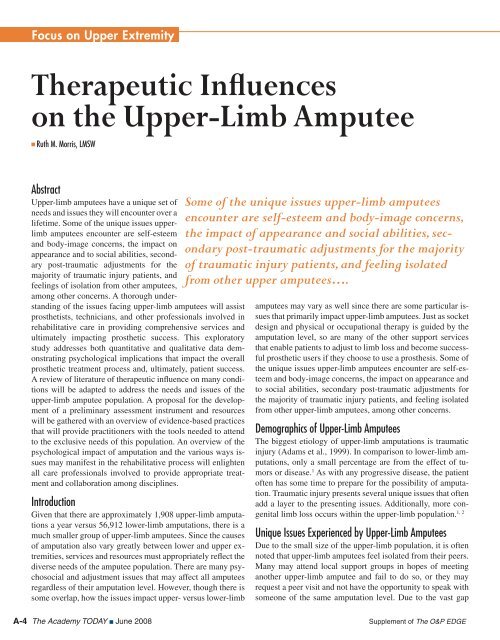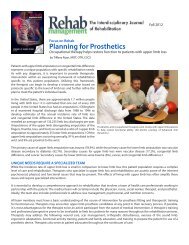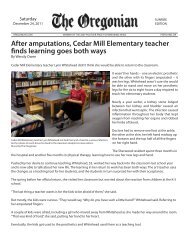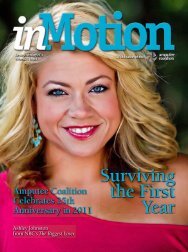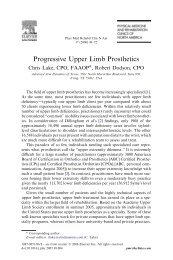Therapeutic Influences on the Upper-Limb Amputee - Advanced Arm ...
Therapeutic Influences on the Upper-Limb Amputee - Advanced Arm ...
Therapeutic Influences on the Upper-Limb Amputee - Advanced Arm ...
You also want an ePaper? Increase the reach of your titles
YUMPU automatically turns print PDFs into web optimized ePapers that Google loves.
Focus <strong>on</strong> <strong>Upper</strong> Extremity<br />
<str<strong>on</strong>g>Therapeutic</str<strong>on</strong>g> <str<strong>on</strong>g>Influences</str<strong>on</strong>g><br />
<strong>on</strong> <strong>the</strong> <strong>Upper</strong>-<strong>Limb</strong> <strong>Amputee</strong><br />
■ Ruth M. Morris, LMSW<br />
Abstract<br />
<strong>Upper</strong>-limb amputees have a unique set of<br />
needs and issues <strong>the</strong>y will encounter over a<br />
lifetime. Some of <strong>the</strong> unique issues upperlimb<br />
amputees encounter are self-esteem<br />
and body-image c<strong>on</strong>cerns, <strong>the</strong> impact <strong>on</strong><br />
appearance and to social abilities, sec<strong>on</strong>dary<br />
post-traumatic adjustments for <strong>the</strong><br />
majority of traumatic injury patients, and<br />
feelings of isolati<strong>on</strong> from o<strong>the</strong>r amputees,<br />
am<strong>on</strong>g o<strong>the</strong>r c<strong>on</strong>cerns. A thorough understanding<br />
of <strong>the</strong> issues facing upper-limb amputees will assist<br />
pros<strong>the</strong>tists, technicians, and o<strong>the</strong>r professi<strong>on</strong>als involved in<br />
rehabilitative care in providing comprehensive services and<br />
ultimately impacting pros<strong>the</strong>tic success. This exploratory<br />
study addresses both quantitative and qualitative data dem<strong>on</strong>strating<br />
psychological implicati<strong>on</strong>s that impact <strong>the</strong> overall<br />
pros<strong>the</strong>tic treatment process and, ultimately, patient success.<br />
A review of literature of <strong>the</strong>rapeutic influence <strong>on</strong> many c<strong>on</strong>diti<strong>on</strong>s<br />
will be adapted to address <strong>the</strong> needs and issues of <strong>the</strong><br />
upper-limb amputee populati<strong>on</strong>. A proposal for <strong>the</strong> development<br />
of a preliminary assessment instrument and resources<br />
will be ga<strong>the</strong>red with an overview of evidence-based practices<br />
that will provide practiti<strong>on</strong>ers with <strong>the</strong> tools needed to attend<br />
to <strong>the</strong> exclusive needs of this populati<strong>on</strong>. An overview of <strong>the</strong><br />
psychological impact of amputati<strong>on</strong> and <strong>the</strong> various ways issues<br />
may manifest in <strong>the</strong> rehabilitative process will enlighten<br />
all care professi<strong>on</strong>als involved to provide appropriate treatment<br />
and collaborati<strong>on</strong> am<strong>on</strong>g disciplines.<br />
Introducti<strong>on</strong><br />
Given that <strong>the</strong>re are approximately 1,908 upper-limb amputati<strong>on</strong>s<br />
a year versus 56,912 lower-limb amputati<strong>on</strong>s, <strong>the</strong>re is a<br />
much smaller group of upper-limb amputees. Since <strong>the</strong> causes<br />
of amputati<strong>on</strong> also vary greatly between lower and upper extremities,<br />
services and resources must appropriately reflect <strong>the</strong><br />
diverse needs of <strong>the</strong> amputee populati<strong>on</strong>. There are many psychosocial<br />
and adjustment issues that may affect all amputees<br />
regardless of <strong>the</strong>ir amputati<strong>on</strong> level. However, though <strong>the</strong>re is<br />
some overlap, how <strong>the</strong> issues impact upper- versus lower-limb<br />
Some of <strong>the</strong> unique issues upper-limb amputees<br />
encounter are self-esteem and body-image c<strong>on</strong>cerns,<br />
<strong>the</strong> impact of appearance and social abilities, sec<strong>on</strong>dary<br />
post-traumatic adjustments for <strong>the</strong> majority<br />
of traumatic injury patients, and feeling isolated<br />
from o<strong>the</strong>r upper amputees….<br />
amputees may vary as well since <strong>the</strong>re are some particular issues<br />
that primarily impact upper-limb amputees. Just as socket<br />
design and physical or occupati<strong>on</strong>al <strong>the</strong>rapy is guided by <strong>the</strong><br />
amputati<strong>on</strong> level, so are many of <strong>the</strong> o<strong>the</strong>r support services<br />
that enable patients to adjust to limb loss and become successful<br />
pros<strong>the</strong>tic users if <strong>the</strong>y choose to use a pros<strong>the</strong>sis. Some of<br />
<strong>the</strong> unique issues upper-limb amputees encounter are self-esteem<br />
and body-image c<strong>on</strong>cerns, <strong>the</strong> impact <strong>on</strong> appearance and<br />
to social abilities, sec<strong>on</strong>dary post-traumatic adjustments for<br />
<strong>the</strong> majority of traumatic injury patients, and feeling isolated<br />
from o<strong>the</strong>r upper-limb amputees, am<strong>on</strong>g o<strong>the</strong>r c<strong>on</strong>cerns.<br />
Demographics of <strong>Upper</strong>-<strong>Limb</strong> <strong>Amputee</strong>s<br />
The biggest etiology of upper-limb amputati<strong>on</strong>s is traumatic<br />
injury (Adams et al., 1999). In comparis<strong>on</strong> to lower-limb amputati<strong>on</strong>s,<br />
<strong>on</strong>ly a small percentage are from <strong>the</strong> effect of tumors<br />
or disease. 1 As with any progressive disease, <strong>the</strong> patient<br />
often has some time to prepare for <strong>the</strong> possibility of amputati<strong>on</strong>.<br />
Traumatic injury presents several unique issues that often<br />
add a layer to <strong>the</strong> presenting issues. Additi<strong>on</strong>ally, more c<strong>on</strong>genital<br />
limb loss occurs within <strong>the</strong> upper-limb populati<strong>on</strong>. 1, 2<br />
Unique Issues Experienced by <strong>Upper</strong>-<strong>Limb</strong> <strong>Amputee</strong>s<br />
Due to <strong>the</strong> small size of <strong>the</strong> upper-limb populati<strong>on</strong>, it is often<br />
noted that upper-limb amputees feel isolated from <strong>the</strong>ir peers.<br />
Many may attend local support groups in hopes of meeting<br />
ano<strong>the</strong>r upper-limb amputee and fail to do so, or <strong>the</strong>y may<br />
request a peer visit and not have <strong>the</strong> opportunity to speak with<br />
some<strong>on</strong>e of <strong>the</strong> same amputati<strong>on</strong> level. Due to <strong>the</strong> vast gap<br />
A-4 The Academy TODAY ■ June 2008 Supplement of The O&P EDGE
in size between <strong>the</strong> two groups, most of <strong>the</strong> literature<br />
and resources available for amputees are unintenti<strong>on</strong>ally<br />
focused <strong>on</strong> lower-limb c<strong>on</strong>cerns. Since<br />
upper-limb amputees are looking for resources and<br />
informati<strong>on</strong> specific to <strong>the</strong>ir questi<strong>on</strong>s, it can become<br />
disheartening to reach out and find no answers.<br />
All amputees experience <strong>the</strong> restructuring of how<br />
<strong>the</strong>y view <strong>the</strong>mselves post-amputati<strong>on</strong>. Compounded<br />
by <strong>the</strong> inability to completely c<strong>on</strong>ceal a hand pros<strong>the</strong>sis or a<br />
missing limb, upper-limb amputees have <strong>the</strong> unique situati<strong>on</strong><br />
of c<strong>on</strong>stantly having <strong>the</strong>ir physical difference exposed. Bodyimage<br />
issues impact upper-limb amputees in a different way<br />
since hands are quite visible in day-to-day life and hold cultural<br />
significance as well. It is standard practice in Western culture<br />
to extend <strong>the</strong> right hand to shake hands and to display wedding<br />
rings <strong>on</strong> <strong>the</strong> left hand. Having to alter how <strong>the</strong>y participate in<br />
<strong>the</strong>se cultural practices may be a reminder of <strong>the</strong> loss <strong>the</strong>y<br />
have experienced and may open <strong>the</strong>m up to discriminati<strong>on</strong><br />
and feeling stigmatized by society. Bilateral arm amputees<br />
are even more impacted by this since people are not sure<br />
how to shake <strong>the</strong>ir hands or pros<strong>the</strong>ses. Although individuals<br />
with disabilities—regardless of <strong>the</strong> type of disability—are<br />
c<strong>on</strong>fr<strong>on</strong>ted daily with <strong>the</strong> positive and negative impact of<br />
<strong>the</strong>ir abilities, <strong>the</strong>re are certain ramificati<strong>on</strong>s when individuals<br />
Unlike lower-limb patients, when upperlimb<br />
amputees lose <strong>the</strong>ir dominant side, <strong>the</strong>y<br />
essentially have to relearn how to do even<br />
<strong>the</strong> simplest tasks.<br />
can never choose to feel invisible or take a break from <strong>the</strong>ir<br />
difference. Even positive attenti<strong>on</strong> focused <strong>on</strong> how <strong>the</strong>y are<br />
able to operate within <strong>the</strong>ir disability can be emoti<strong>on</strong>ally<br />
taxing over time.<br />
Functi<strong>on</strong>ality of tasks is impacted by <strong>the</strong> loss of an upper<br />
limb. The varying grasping patterns and dexterity abilities of<br />
<strong>the</strong> human hand can be difficult to replace. Many daily activities<br />
are eased by having two hands to perform <strong>the</strong> task. Depending<br />
up<strong>on</strong> <strong>the</strong> level of amputati<strong>on</strong>, o<strong>the</strong>r sustaining injuries, and<br />
pros<strong>the</strong>tic opti<strong>on</strong>s available, learning to perform certain tasks<br />
can be a l<strong>on</strong>g process requiring intense occupati<strong>on</strong>al <strong>the</strong>rapy.<br />
Unlike lower-limb patients, when upper-limb amputees lose<br />
<strong>the</strong>ir dominant side, <strong>the</strong>y essentially have to relearn how to<br />
do even <strong>the</strong> simplest tasks. The loss of <strong>the</strong> dominant hand can<br />
have a profound impact since it alters ways in which upperlimb<br />
amputees may have identified <strong>the</strong>mselves, such as <strong>the</strong>ir<br />
Supplement of The O&P EDGE June 2008 ■ The Academy TODAY A-5
handwriting, playing an instrument, drawing, painting, or<br />
cooking. During <strong>the</strong> relearning phase, upper-limb functi<strong>on</strong>al<br />
activities may have a bigger learning curve than lower-limb<br />
mobility activities. Fur<strong>the</strong>rmore, <strong>the</strong>re are an unlimited<br />
number of tasks in which hand movement is used, adding to<br />
<strong>the</strong> complexity of <strong>the</strong> limb loss.<br />
Al<strong>on</strong>g with traumatic injuries come particular issues<br />
that impact many affected by upper-limb amputati<strong>on</strong>. Often<br />
pers<strong>on</strong>s may experience symptoms of post-traumatic stress<br />
disorder (PTSD). This may manifest in <strong>the</strong> individual through<br />
recurring nightmares or flashbacks of <strong>the</strong> accident, avoidance<br />
of <strong>the</strong> topic, emoti<strong>on</strong>al numbing, or <strong>the</strong> development of<br />
hyperarousal. Forgoing treatment of PTSD can impact<br />
whe<strong>the</strong>r amputees choose to wear a pros<strong>the</strong>sis and <strong>the</strong>ir ability<br />
to be successful pros<strong>the</strong>tic users. Additi<strong>on</strong>ally, phantom limb<br />
pain can also impact indiv iduals to <strong>the</strong> point of impeding<br />
<strong>the</strong>ir ability to cope with <strong>the</strong>ir limb loss and progress in<br />
The reputati<strong>on</strong> of upper-limb amputees for<br />
rejecting pros<strong>the</strong>tic devices at a high rate<br />
provokes <strong>the</strong> questi<strong>on</strong> of what resources are<br />
needed to enable <strong>the</strong>m to cope with <strong>the</strong>ir limb<br />
loss and ultimately cope with <strong>the</strong>ir pros<strong>the</strong>sis.<br />
rehabilitati<strong>on</strong>.<br />
Review of <strong>the</strong> Existing Literature<br />
At this time <strong>the</strong> author was unable to identify any existing research<br />
solely focusing <strong>on</strong> <strong>the</strong> psychosocial issues impacting<br />
upper-limb amputees. Out of 11 studies addressing upper- and<br />
lower-limb amputees toge<strong>the</strong>r, <strong>the</strong> sample size of upper-limb<br />
amputees used is much smaller. Although <strong>the</strong>re are proporti<strong>on</strong>ately<br />
fewer upper-limb amputees, <strong>the</strong> sample sizes used do not<br />
reflect <strong>the</strong> entire populati<strong>on</strong>. The studies ranged from interviewing<br />
four upper-limb versus 90 lower-limb participants 3 to<br />
interviewing 97.4 percent lower-limb patients versus 2.6 percent<br />
upper-limb patients. 4 Additi<strong>on</strong>ally, most studies included<br />
below-elbow participants and occasi<strong>on</strong>ally an above-elbow participant.<br />
Many of <strong>the</strong> studies encompassed <strong>the</strong> various levels of<br />
lower-limb amputati<strong>on</strong> as well as lower bilateral patients.<br />
Previous studies support that emoti<strong>on</strong>al adjustment takes<br />
l<strong>on</strong>ger for upper-limb amputees and those who have had a<br />
traumatic accident, many of whom are upper-limb amputees.<br />
Likewise, a study by Price and Fisher 5 supports both upperlimb<br />
and traumatic amputees as being <strong>the</strong> most emoti<strong>on</strong>ally<br />
affected. 6, 7 The literature reviewed did not expound up<strong>on</strong><br />
causes or specific c<strong>on</strong>cerns leading to this deducti<strong>on</strong>.<br />
It was noted that in more than <strong>on</strong>e article, issues specific to<br />
lower-limb amputees such as mobility and gait analysis were<br />
addressed. In <strong>the</strong> Nicholas et al. 3 study reviewed, <strong>the</strong>re were<br />
no paralleling functi<strong>on</strong>ality issues addressed with <strong>the</strong> upperlimb<br />
sample. Several questi<strong>on</strong>s referred to lower limb-specific<br />
activities such as buying shoes, buying pants, going out despite<br />
<strong>the</strong> wea<strong>the</strong>r, rehabilitati<strong>on</strong> training of climbing stairs, walking<br />
<strong>on</strong> an inclined plane, and vehicle transfers. Several studies<br />
solely evaluating leg amputees examined in detail everyday<br />
functi<strong>on</strong>ing skills such as walking, biking, and driving.<br />
An interesting c<strong>on</strong>clusi<strong>on</strong> in <strong>the</strong> study of coping strategies<br />
by Gallagher and MacLachlan 8 supports that “patients who<br />
express dissatisfacti<strong>on</strong> with <strong>the</strong>ir pros<strong>the</strong>ses may be doing so as<br />
a form of denial or as an excuse for an inability to cope with <strong>the</strong><br />
pros<strong>the</strong>sis.” The reputati<strong>on</strong> of upper-limb amputees for rejecting<br />
pros<strong>the</strong>tic devices at a high rate provokes <strong>the</strong> questi<strong>on</strong> of what<br />
resources are needed to enable <strong>the</strong>m to cope with <strong>the</strong>ir limb loss<br />
and ultimately cope with <strong>the</strong>ir pros<strong>the</strong>sis.<br />
Several studies support existing <strong>the</strong>ories that body image per-<br />
9, 10<br />
cepti<strong>on</strong> and mourning <strong>the</strong> loss of a limb impact adjustment.<br />
Included in <strong>the</strong> literature c<strong>on</strong>centrating <strong>on</strong> lowerlimb<br />
pres entati<strong>on</strong>, many studies support <strong>the</strong> loss of<br />
independence in mobility and inability to perform<br />
enjoyed activities as factors in adjustment. 11 Body<br />
image, perceived social stigma, and social support<br />
were issues that repeatedly surfaced in various studies<br />
as well. In a study by Rybarczyk et al., 12 several scales<br />
were devel oped to measure <strong>the</strong> psychosocial adjustment<br />
to leg amputati<strong>on</strong>. The findings led to <strong>the</strong> c<strong>on</strong>clusi<strong>on</strong><br />
that mental health professi<strong>on</strong>als need to be involved in <strong>the</strong> care<br />
of this populati<strong>on</strong> in additi<strong>on</strong> to a screening tool being available<br />
to routinely address psychological adjustment.<br />
Comparis<strong>on</strong> with O<strong>the</strong>r Disciplines<br />
A cursory review of literature of related disciplines dem<strong>on</strong>strates<br />
<strong>the</strong> methods in which similar fields have identified issues<br />
and developed resources in resp<strong>on</strong>se to those issues. Fields<br />
such as visi<strong>on</strong> loss, physical disabilities, diabetes, and muscular<br />
dystrophy, which have some overlapping psychosocial issues,<br />
were reviewed. Several studies utilized focus groups to identify<br />
comm<strong>on</strong> issues am<strong>on</strong>g <strong>the</strong> populati<strong>on</strong> as was d<strong>on</strong>e in <strong>the</strong> Owsley<br />
et al. study of age-related macular degenerati<strong>on</strong>. 16 Based<br />
up<strong>on</strong> several studies, <strong>the</strong> diabetes field has begun to develop<br />
programs and educati<strong>on</strong>al models to promote healthy coping. 17<br />
Am<strong>on</strong>g <strong>the</strong> resources in place are patient psychoeducati<strong>on</strong>al<br />
classes, support groups, and family <strong>the</strong>rapy. Many articles also<br />
promote training and support programs for families to address<br />
<strong>the</strong>ir own adjustment and that of <strong>the</strong> patient. 18 Fur<strong>the</strong>rmore, several<br />
studies in each of <strong>the</strong>se fields also support <strong>the</strong> c<strong>on</strong>clusi<strong>on</strong><br />
that an interdisciplinary team is necessary to meet all of <strong>the</strong><br />
patient’s needs.<br />
Need for Fur<strong>the</strong>r Research<br />
At this time, <strong>the</strong> needs of upper-limb amputees have not thoroughly<br />
been studied to address <strong>the</strong> specific nuances of <strong>the</strong> reha-<br />
A-6 The Academy TODAY ■ June 2008 Supplement of The O&P EDGE
ilitative process. A l<strong>on</strong>gitudinal study with a large sample size<br />
in proporti<strong>on</strong> to <strong>the</strong> overall number of upper-limb amputees is<br />
proposed to fur<strong>the</strong>r identify <strong>the</strong> specific issues. Specific questi<strong>on</strong>s<br />
need to address functi<strong>on</strong>ality and day-to-day issues impacted<br />
by <strong>the</strong> loss of an arm and how this interplays with o<strong>the</strong>r<br />
issues such as body image, perceived stigma, and acceptance.<br />
Particular attenti<strong>on</strong> also needs to be directed to evaluating bilateral<br />
upper-limb amputees in regard to any variati<strong>on</strong>s in how<br />
<strong>the</strong>se issues impact <strong>the</strong>m. Also needed is a thorough study of <strong>the</strong><br />
many levels of upper-limb amputati<strong>on</strong> from <strong>the</strong> loss of fingers<br />
to <strong>the</strong> shoulder disarticulati<strong>on</strong> level. Centered up<strong>on</strong> <strong>the</strong> results<br />
of <strong>the</strong> survey, a screening evaluati<strong>on</strong> tool to determine <strong>the</strong> coping<br />
and acceptance of upper-limb amputees would be helpful.<br />
Based up<strong>on</strong> <strong>the</strong> development and administrati<strong>on</strong> of this tool,<br />
upper-limb amputees can be referred to appropriate services as<br />
needed. Additi<strong>on</strong>al service models can be developed to address<br />
<strong>the</strong> identified needs where <strong>the</strong>y are not currently met. Opportunities<br />
to study <strong>the</strong> effect of addressing <strong>the</strong> psychosocial issues<br />
<strong>on</strong> pros<strong>the</strong>tic success would also be possible in future studies,<br />
in additi<strong>on</strong> to <strong>the</strong> role and specific coping issues of family members.<br />
This tool will be helpful for those professi<strong>on</strong>als who may<br />
not work exclusively with upper-limb amputees and who may<br />
o<strong>the</strong>rwise overlook <strong>the</strong> many ways in which an upper-limb loss<br />
impacts <strong>the</strong> individual. Though several studies have found that<br />
upper-limb patients have a higher rate of emoti<strong>on</strong>al disturbance,<br />
no evidence points to what specific issues would address <strong>the</strong><br />
emoti<strong>on</strong>al disturbance. In c<strong>on</strong>clusi<strong>on</strong>, <strong>the</strong>re are many opportunities<br />
to evaluate <strong>the</strong> specific needs of upper-limb amputees in<br />
order to best develop tools and resources for ultimate patient<br />
success. As new technologies and advancements in upper-limb<br />
pros<strong>the</strong>tic opti<strong>on</strong>s emerge, so must <strong>the</strong> support systems to enable<br />
and empower patients for success.<br />
References<br />
1. Dillingham, T.R.; Pezzin, L.E.; MacKenzie; E J.<br />
“<strong>Limb</strong> Amputati<strong>on</strong> and <strong>Limb</strong> Deficiency: Epidemiology<br />
and Recent Trends in <strong>the</strong> United States.”<br />
Sou<strong>the</strong>rn Medical Journal, 2002; 95: 875-83.<br />
2. Adams, P.F., et al. “Current Estimates from <strong>the</strong><br />
Nati<strong>on</strong>al Health Interview Survey,” 1996. Vital and<br />
Health Statistics 1999; 10:200.<br />
3. Nicholas, J.J.; Robins<strong>on</strong>, L.R.; Schulz, R.; et al.<br />
“Problems Experienced and Perceived by Pros<strong>the</strong>tic<br />
Patients.” Journal of Pros<strong>the</strong>tics and Orthotics 1993,<br />
5:16.<br />
4. Phelps, L.F.; Williams, R.M.; Raichle, K.A.; et al.<br />
“The Importance of Cognitive Processing Adjustment<br />
in <strong>the</strong> 1 st Year Following Amputati<strong>on</strong>.” Rehabilitati<strong>on</strong><br />
Psychology 2008, 53:28-38.<br />
5. Price, E.M.; Fisher, K. “How Does Counseling Help<br />
People with Amputati<strong>on</strong>?” Journal of Pros<strong>the</strong>tics<br />
and Orthotics 2002, 14:102.<br />
6. Price, E.M.; Fisher, K. “Additi<strong>on</strong>al Studies of <strong>the</strong><br />
Emoti<strong>on</strong>al Needs of <strong>Amputee</strong>s.” Journal of Pros<strong>the</strong>tics<br />
and Orthotics 2005, 17:52.<br />
7. Price, E.M.; Fisher, K. “Fur<strong>the</strong>r Study of <strong>the</strong> Emoti<strong>on</strong>al<br />
Needs of <strong>Amputee</strong>s.” Journal of Pros<strong>the</strong>tics<br />
and Orthotics 2007, 19:106.<br />
8. Gallagher, P.; MacLachlan, M. “Psychological<br />
Adjustment and Coping in Adults with Pros<strong>the</strong>tic<br />
<strong>Limb</strong>s.” Behavioral Medicine 1999, 25:117.<br />
9. Maguire, P.; Parkes, C.M. “Surgery and Loss of Body<br />
Parts.” BMJ 1998, 316:1086-1088.<br />
10. Anderss<strong>on</strong>, M.; Deighan, F. Coping Strategies in<br />
C<strong>on</strong>juncti<strong>on</strong> with Amputati<strong>on</strong>. Divisi<strong>on</strong> for Health<br />
and Caring Sciences, Karlstads University, 2006.<br />
11. Walters, J. “Coping with Leg Amputati<strong>on</strong>.” American<br />
Journal of Nursing 1981, 81:1349-1352.<br />
12. Rybarczyk, B.; Nyenhuis, D.L.; Nicholas, J.J.; et al.<br />
“Body Image, Perceived Social Stigma, and <strong>the</strong> Predicti<strong>on</strong><br />
of Psychosocial Adjustment to Leg Amputati<strong>on</strong>.”<br />
Rehabilitati<strong>on</strong> Psychology 1995, 40:95-110.<br />
13. Bosmans, J.C.; Suurmeijer, T.P.B.M.; Hulsink, M.; et<br />
al. “Amputati<strong>on</strong>, Phantom Pain and Subjective Wellbeing:<br />
A Qualitative Study.” Internati<strong>on</strong>al Journal of<br />
Rehabilitati<strong>on</strong> 2007, 30:1-8.<br />
14. Isken, T.; Ege, O.; Gucer, K.; et al. “A Preliminary<br />
Report: Evaluati<strong>on</strong> of <strong>the</strong> Psychiatric Status of<br />
Patients Who Had Underg<strong>on</strong>e Major Amputati<strong>on</strong><br />
because of High-voltage Electrical Burns.” Journal<br />
of Burn Care & Research 2007, 28:930.<br />
15. Mans<strong>on</strong>, M.P.; Devins, G.V. “Some Psychological<br />
Findings in <strong>the</strong> Rehabilitati<strong>on</strong> of <strong>Amputee</strong>s.” Journal<br />
of Clinical Psychology 2006, 9:65-66.<br />
16. Owsley, C.; McGwin, G.; Scilley, K.; et al. “Focus<br />
Groups with Pers<strong>on</strong>s Who Have Age-related Macular<br />
Degenerati<strong>on</strong>: Emoti<strong>on</strong>al Issues.” Psychological<br />
Aspects of Disability, 2006, 51:23-29.<br />
17. Fisher, E.B.; Thorpe, C.T.; DeVellis, B.M.; DeVellis,<br />
R.F. “Healthy Coping, Negative Emoti<strong>on</strong>s, and<br />
Diabetes Management: A Systematic Review and<br />
Appraisal.” The Diabetes Educator 2007, 33:1080.<br />
18. Wils<strong>on</strong>, S.; Engel, J.M.; Ciol, M.A.; Jensen, M.P.<br />
“Perceived Social Support, Psychological Adjustment,<br />
and Functi<strong>on</strong>al Ability in Youths with Physical<br />
Disabilities.” Rehabilitati<strong>on</strong> Psychology 2006,<br />
51:322-330.<br />
Ruth M. Morris, LMSW, is affiliated with <strong>Advanced</strong> <strong>Arm</strong> Dynamics Southwest<br />
Center of Excellence, Irving, Texas. Send<br />
corresp<strong>on</strong>dence to Ruth M. Morris, LMSW;<br />
3501 North Macarthur Boulevard, Suite<br />
650; Irving, TX 75062; e-mail: rmorris@<br />
armdynamics.com<br />
Supplement of The O&P EDGE June 2008 ■ The Academy TODAY A-7


